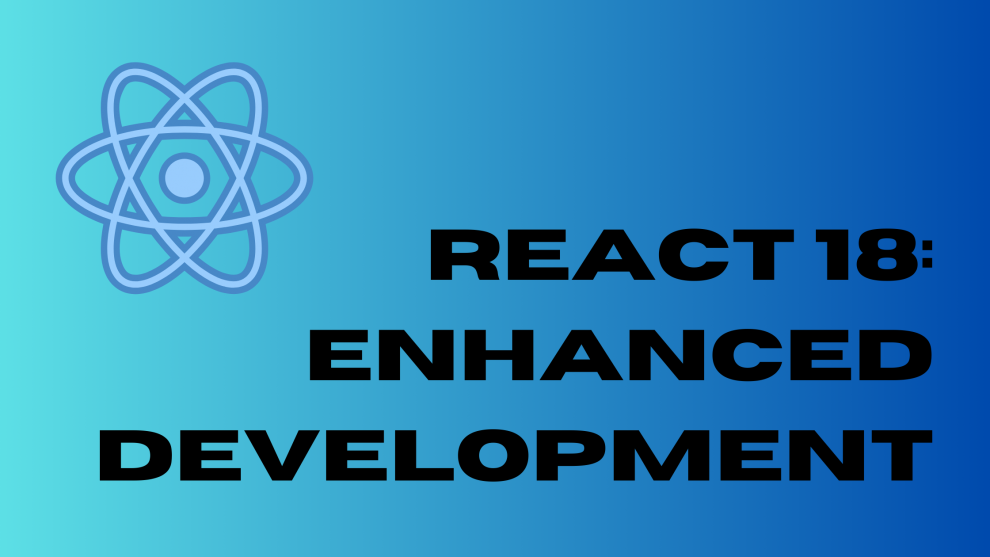Welcome to the dynamic realm of React 18! Representing the latest iteration of this robust JavaScript library, React 18 introduces a host of innovative features and enhancements that promise to elevate the development experience. Whether you’re an experienced React developer or just embarking on your coding journey, prepare for an exhilarating exploration of the advancements React 18 brings to the forefront. From concurrent rendering to automatic batching and suspense for data fetching, React 18 stands poised to redefine the landscape of front-end development, offering developers powerful tools to create more efficient, scalable, and dynamic user interfaces.
Concurrent rendering
Concurrent rendering represents a fundamental shift in React’s rendering engine, enabling it to concurrently handle multiple tasks. This advancement holds the potential for substantial performance enhancements, particularly in applications with intricate user interfaces or substantial data loads.
How it Operates
Concurrent rendering employs a two-phase rendering pipeline. In the initial phase, React generates a new component tree based on the most recent state updates. The second phase involves committing this new tree to the DOM.
The crucial aspect is that the rendering’s first phase can be interrupted at any point. This flexibility allows React to initiate the rendering of a new component tree even if it’s still processing the previous one.
React then commits the updated tree to the DOM as soon as the rendering process is completed. Consequently, users consistently experience the latest UI version, even when React is still engaged in rendering a new tree.
Advantages
Concurrent rendering offers several advantages, including:
Enhanced Performance:
By concurrently managing multiple tasks, React can significantly accelerate UI rendering, particularly beneficial for applications with intricate interfaces or substantial data loads.
Improved Responsiveness:
Concurrent rendering contributes to enhanced application responsiveness. React can continue responding to user input even during resource-intensive tasks, such as data retrieval or rendering complex animations.
Reduced Jank:
Jank, characterized by a sense of lag or unresponsiveness due to inconsistent UI rendering, can be mitigated. Concurrent rendering ensures an up-to-date UI, minimizing instances of jank, even when React is mid-process in rendering a new tree.
Implementation
To implement concurrent rendering, upgrading to React 18 is the primary requirement. Notably, concurrent rendering is enabled by default, necessitating no alterations to your existing code.
For optimal utilization of concurrent rendering, consider the following:
Utilize Transitions:
Prioritize state updates using transitions to ensure that critical updates are applied first. This helps maintain application responsiveness during concurrent tasks.
Incorporate Suspense:
Improve performance and responsiveness by using Suspense to render components awaiting data without obstructing the rest of the UI.
Minimize Unnecessary State Updates:
To prevent performance issues, restrict state updates to instances where they are genuinely necessary. Avoid unnecessary updates for a smoother user experience.
Automatic batching
Automatic batching is a recent feature introduced in React 18 that streamlines the process of applying multiple state updates simultaneously. This enhancement contributes to optimizing rendering performance by minimizing the number of times React has to re-render the UI.
Before React 18, if there were multiple state updates within a single event handler, React would trigger a component render after each update. This practice often resulted in unnecessary re-renders and posed performance challenges.
Automatic batching addresses this issue by consolidating state updates and triggering a single component render after all updates have been applied.
How it Operates
Automatic batching keeps track of scheduled state updates. When the next batch of updates is ready for application, React consolidates and flushes them together, triggering a single UI re-render.
Advantages
Automatic batching offers several benefits, including:
Enhanced Performance:
By reducing the frequency of UI re-renders, automatic batching significantly improves performance, particularly for applications with intricate interfaces or large datasets.
Reduced Jank:
Jank, characterized by lag or unresponsiveness due to inconsistent UI rendering, can be mitigated. Automatic batching ensures that the UI is re-rendered only once after all state updates have been applied, minimizing instances of jank.
Improved Responsiveness:
Automatic batching enhances application responsiveness by allowing React to continue responding to user input even during the application of state updates.
Implementation
Automatic batching is activated by default in React 18, requiring no adjustments to existing code.
For optimal utilization of automatic batching, consider the following:
Use Transitions:
Prioritize state updates using transitions to ensure that critical updates are applied first. This aids in maintaining application responsiveness during concurrent tasks.
Incorporate Suspense:
Improve performance and responsiveness by using Suspense to render components awaiting data without obstructing the rest of the UI.
Minimize Unnecessary State Updates:
To prevent performance issues, restrict state updates to instances where they are genuinely necessary. Avoid unnecessary updates for a smoother user experience.
Transitions
Transitions emerge as a novel API in React 18, enabling you to prioritize state updates and ensure that critical changes take precedence. This proves valuable in maintaining the responsiveness of your application, particularly when it is engaged in concurrent tasks like data fetching or rendering intricate animations.
How it Operates
To employ transitions, simply invoke the startTransition function before initiating state updates that demand prioritization. React will then guarantee that these updates take precedence, even if they aren’t the next in line for processing.
For instance, the following JavaScript code illustrates the use of transitions to prioritize a state update altering the document’s title:
import { useState, startTransition } from 'react';
const MyComponent = () => {
const [title, setTitle] = useState('My Title');
const handleClick = () => {
startTransition(() => {
setTitle('New Title');
});
};
return (
<div>
<h1>{title}</h1>
<button onClick={handleClick}>Change Title</button>
</div>
);
};
export default MyComponent;In this example, the handleClick function invokes the startTransition function before updating the title state. This ensures that the state update is prioritized, even if React is still in the process of rendering something else.
Advantages
Transitions offer several advantages, including:
Improved Responsiveness:
Transitions assist in maintaining application responsiveness during concurrent tasks. By prioritizing essential state updates, transitions ensure critical changes are promptly applied.
Reduced Jank:
Transitions contribute to reducing jank, the feeling of lag or unresponsiveness caused by inconsistent UI rendering. By prioritizing updates, transitions help in keeping the UI consistently up-to-date.
Implementation
To incorporate transitions, a simple upgrade to React 18 suffices. Transitions are automatically enabled, requiring no alterations to your existing code.
For optimal use of transitions, consider the following tips:
Use Transitions Wisely:
Reserve transitions for prioritizing state updates crucial to your application’s responsiveness. Excessive use of transitions may lead to performance issues.
Incorporate Suspense:
Improve performance and responsiveness by using Suspense to render components awaiting data without blocking the rest of the UI.
Minimize Unnecessary State Updates:
Restrict state updates to instances where they are genuinely necessary to prevent potential performance problems. Avoid unnecessary updates for a smoother user experience.
Suspense server rendering
Suspense server rendering is a fresh feature introduced in React 18, allowing you to leverage Suspense for rendering components on the server, even when they are awaiting data. This enhancement aims to enhance the initial load time of your application and deliver a more uniform user experience across various devices.
How it Operates
Prior to React 18, if Suspense was employed to render a server-side component, React would wait until all the necessary data was loaded before proceeding with the rendering. This approach often resulted in a slow initial load time, especially for applications dealing with substantial datasets.
Suspense server rendering rectifies this issue by enabling React to render the component on the server, even during data retrieval. Subsequently, React streams the data to the client and updates the component as the data arrives.
Implementation
To implement Suspense server rendering, a straightforward upgrade to React 18 suffices. Wrap your Suspense components in the renderToPipeableStream function. This function returns a stream of HTML, which can be streamed to the client.
Here’s an example in JavaScript:
import { renderToPipeableStream, useState } from 'react';
const MyComponent = () => {
const [data, setData] = useState(null);
useEffect(() => {
fetch('/api/data')
.then(response => response.json())
.then(data => setData(data));
}, []);
return (
<Suspense>
<h1>{data && data.title}</h1>
</Suspense>
);
};
const htmlStream = renderToPipeableStream(<MyComponent />);
// Stream the HTML to the client
htmlStream.pipe(response);In this example, renderToPipeableStream renders the MyComponent component, returning a stream of HTML, which is then sent to the client using the response object.
Advantages
Suspense server rendering yields several advantages, including:
Improved Initial Load Time:
By allowing server-side rendering despite data loading, Suspense server rendering enhances the initial load time of your application.
Consistent User Experience:
Suspense server rendering contributes to a more consistent user experience across different devices. It ensures that the UI remains up-to-date, even as the client continues to load data.
Reduced Jank:
Jank, characterized by lag or unresponsiveness due to inconsistent UI rendering, can be mitigated. Suspense server rendering ensures the UI stays current, even during the client’s data loading phase.
How to Use it
To incorporate Suspense server rendering, upgrade to React 18 and use the renderToPipeableStream function to wrap your Suspense components. Subsequently, you can employ various methods to stream the HTML to the client, such as utilizing a web server or a streaming service.
Other Improvements
In addition to the aforementioned features and enhancements, React 18 incorporates several other improvements, including:
Strict Mode:
Strict mode is a developmental tool designed to pinpoint potential issues in your application, such as unexpected remounting or unmounting of components. While Strict mode is enabled by default in React 18, it can be disabled if necessary.
New Root API:
React 18 introduces a new root API that simplifies the management of multiple React root elements within a single application. This proves beneficial for applications with diverse UI components, such as modals or popovers.
Improved Error Handling:
React 18 facilitates more straightforward error management in your application, encompassing errors that may arise during server rendering. The introduction of the ErrorBoundary component in React 18 provides a mechanism to catch and handle errors efficiently.
Other Performance Improvements:
React 18 encompasses additional performance enhancements, including refined tree reconciliation and garbage collection. These optimizations contribute to making your applications faster and more responsive.
Conclusion
In conclusion, React 18 represents a pivotal moment in the ongoing evolution of front-end development. With groundbreaking features such as concurrent rendering, automatic batching, and suspense for data fetching, React 18 empowers developers to craft more responsive and efficient user interfaces. The commitment to backward compatibility ensures a seamless transition for existing projects, while the potential for real-time, interactive applications opens up thrilling possibilities for the future. As we embrace these changes, React 18 signifies not just an update but a substantial leap forward in the ever-changing landscape of web development. The journey with React 18 invites developers to explore, experiment, and contribute to shaping the next generation of exceptional user experiences. Feel free to reach out to us.

























